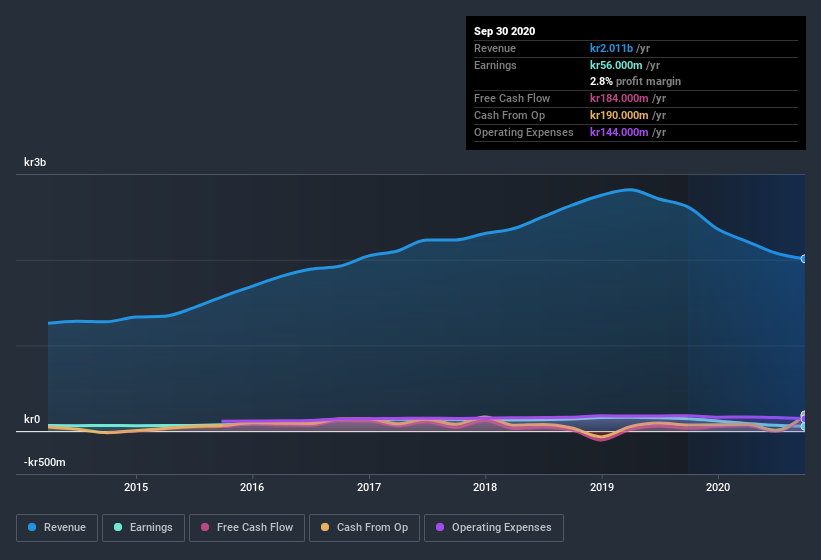Are KABE Group AB (publ.)'s (STO:KABE B) Statutory Earnings A Good Reflection Of Its Earnings Potential?
Many investors consider it preferable to invest in profitable companies over unprofitable ones, because profitability suggests a business is sustainable. That said, the current statutory profit is not always a good guide to a company's underlying profitability. Today we'll focus on whether this year's statutory profits are a good guide to understanding KABE Group AB (publ.) (STO:KABE B).
While KABE Group AB (publ.) was able to generate revenue of kr2.01b in the last twelve months, we think its profit result of kr56.0m was more important. The chart below shows that both revenue and profit have declined over the last three years.
See our latest analysis for KABE Group AB (publ.)

Of course, it is only sensible to look beyond the statutory profits and question how well those numbers represent the sustainable earnings power of the business. Today, we'll discuss KABE Group AB (publ.)'s free cashflow relative to its earnings, and consider what that tells us about the company. Note: we always recommend investors check balance sheet strength. Click here to be taken to our balance sheet analysis of KABE Group AB (publ.).
Zooming In On KABE Group AB (publ.)'s Earnings
In high finance, the key ratio used to measure how well a company converts reported profits into free cash flow (FCF) is the accrual ratio (from cashflow). In plain english, this ratio subtracts FCF from net profit, and divides that number by the company's average operating assets over that period. The ratio shows us how much a company's profit exceeds its FCF.
Therefore, it's actually considered a good thing when a company has a negative accrual ratio, but a bad thing if its accrual ratio is positive. While it's not a problem to have a positive accrual ratio, indicating a certain level of non-cash profits, a high accrual ratio is arguably a bad thing, because it indicates paper profits are not matched by cash flow. Notably, there is some academic evidence that suggests that a high accrual ratio is a bad sign for near-term profits, generally speaking.
KABE Group AB (publ.) has an accrual ratio of -0.13 for the year to September 2020. Therefore, its statutory earnings were quite a lot less than its free cashflow. To wit, it produced free cash flow of kr184m during the period, dwarfing its reported profit of kr56.0m. KABE Group AB (publ.) shareholders are no doubt pleased that free cash flow improved over the last twelve months.
Our Take On KABE Group AB (publ.)'s Profit Performance
KABE Group AB (publ.)'s accrual ratio is solid, and indicates strong free cash flow, as we discussed, above. Because of this, we think KABE Group AB (publ.)'s earnings potential is at least as good as it seems, and maybe even better! On the other hand, its EPS actually shrunk in the last twelve months. The goal of this article has been to assess how well we can rely on the statutory earnings to reflect the company's potential, but there is plenty more to consider. If you'd like to know more about KABE Group AB (publ.) as a business, it's important to be aware of any risks it's facing. To that end, you should learn about the 2 warning signs we've spotted with KABE Group AB (publ.) (including 1 which doesn't sit too well with us).
This note has only looked at a single factor that sheds light on the nature of KABE Group AB (publ.)'s profit. But there are plenty of other ways to inform your opinion of a company. For example, many people consider a high return on equity as an indication of favorable business economics, while others like to 'follow the money' and search out stocks that insiders are buying. While it might take a little research on your behalf, you may find this free collection of companies boasting high return on equity, or this list of stocks that insiders are buying to be useful.
If you decide to trade KABE Group AB (publ.), use the lowest-cost* platform that is rated #1 Overall by Barron’s, Interactive Brokers. Trade stocks, options, futures, forex, bonds and funds on 135 markets, all from a single integrated account. Promoted
Valuation is complex, but we're here to simplify it.
Discover if KABE Group AB (publ.) might be undervalued or overvalued with our detailed analysis, featuring fair value estimates, potential risks, dividends, insider trades, and its financial condition.
Access Free AnalysisThis article by Simply Wall St is general in nature. It does not constitute a recommendation to buy or sell any stock, and does not take account of your objectives, or your financial situation. We aim to bring you long-term focused analysis driven by fundamental data. Note that our analysis may not factor in the latest price-sensitive company announcements or qualitative material. Simply Wall St has no position in any stocks mentioned.
*Interactive Brokers Rated Lowest Cost Broker by StockBrokers.com Annual Online Review 2020
Have feedback on this article? Concerned about the content? Get in touch with us directly. Alternatively, email editorial-team (at) simplywallst.com.
About OM:KABE B
KABE Group AB (publ.)
Engages in the construction and sale of caravans, motorhomes, and camping accessories in Sweden, the United Kingdom, Germany, Norway, Finland, Denmark, Poland, and internationally.
Excellent balance sheet average dividend payer.
Similar Companies
Market Insights
Community Narratives



